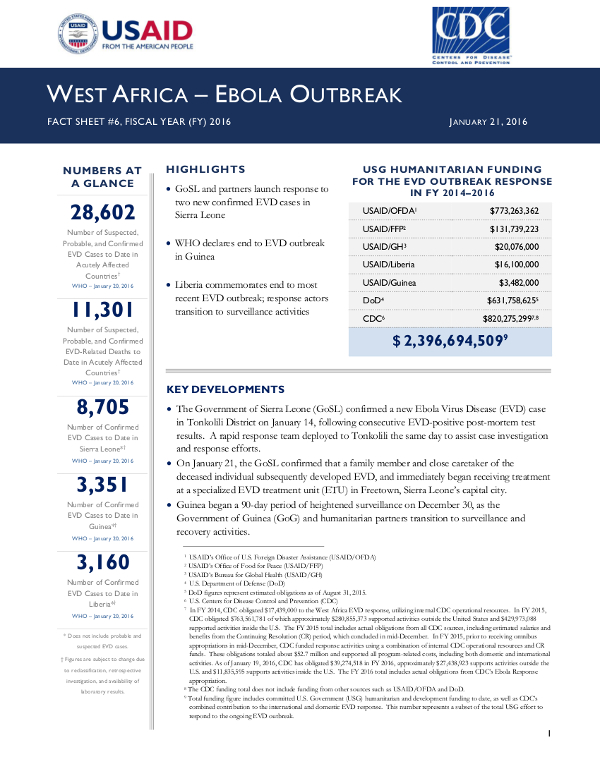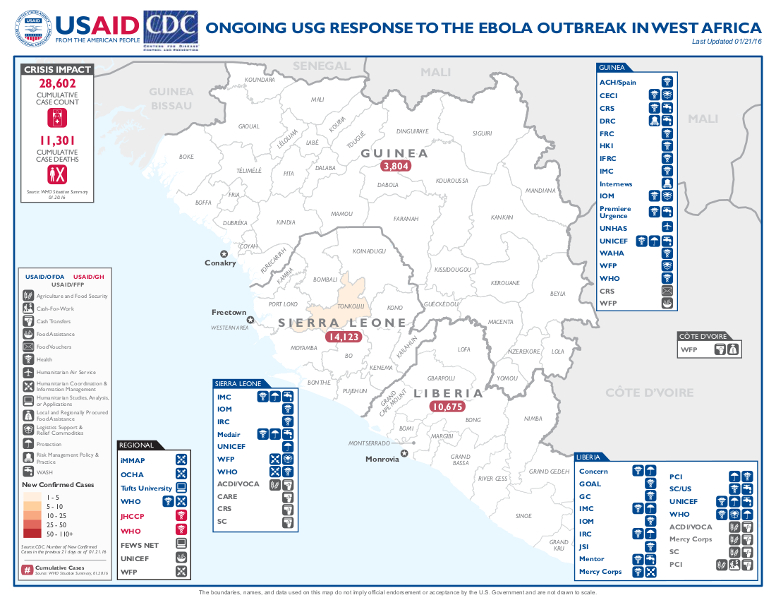Speeches Shim
January 21, 2016
HIGHLIGHTS
Ebola Response
Visit our main West Africa Ebola Outbreak page to learn more about how we're responding to the West Africa Ebola outbreak, and what you can do to help.
- GoSL and partners launch response to two new confirmed EVD cases in Sierra Leone
- WHO declares end to EVD outbreak in Guinea
- Liberia commemorates end to most recent EVD outbreak; response actors transition to surveillance activities
KEY DEVELOPMENTS
- The Government of Sierra Leone (GoSL) confirmed a new Ebola Virus Disease (EVD) case in Tonkolili District on January 14, following consecutive EVD-positive post-mortem test results. A rapid response team deployed to Tonkolili the same day to assist case investigation and response efforts.
- On January 21, the GoSL confirmed that a family member and close caretaker of the deceased individual subsequently developed EVD, and immediately began receiving treatment at a specialized EVD treatment unit (ETU) in Freetown, Sierra Leone’s capital city.
- Guinea began a 90-day period of heightened surveillance on December 30, as the Government of Guinea (GoG) and humanitarian partners transition to surveillance and recovery activities
Regional
The regional USG Disaster Assistance Response Team (DART) and Washington, D.C.-based Response Management Team (RMT) deactivated on January 4, 2016. USAID/OFDA remains in the acutely affected countries of Guinea, Liberia, and Sierra Leone to bolster in-country capacity to respond to new EVD cases and coordinate with development partners and international health actors on the transition from emergency response to long-term recovery.
Sierra Leone
On January 14, the GoSL confirmed a new EVD case in Tonkolili, following three consecutive EVD-positive postmortem test results. According to the UN World Health Organization (WHO), the infected individual—a 22-year-old woman—became symptomatic on January 3 and traveled to four districts prior to her death in Tonkolili’s Magburaka village on January 12. On January 21, the GoSL confirmed a second EVD case—a family member who cared for the deceased woman prior to her death. WHO reported that health workers began treating the infected individual at the 34 Military ETU in Freetown on the same day. The source of EVD transmission remained unconfirmed as of January 19. WHO had previously declared Sierra Leone free of EVD transmission on November 7; the country was scheduled to complete a 90-day period of post-EVD heightened surveillance on February 5.
A rapid response team including representatives from the GoSL, CDC, UK Department for International Development (DFID), UN Children’s Fund (UNICEF), and WHO deployed on January 15 to support district- and local-level response coordination efforts in Kambia, Tonkolili, and other affected districts.
To address case management needs, UNICEF has dispatched community care center kits to affected districts to support the establishment of temporary isolation units. In the event of suspected or additional confirmed cases, there are currently 34 beds designated for isolation across the four most-affected districts, according to the GoSL’s Public Health National Emergency Operations Center. Treatment capacity is currently available at Western Area’s 34 Military ETU, where the second case is receiving care.
As of January 19, the GoSL was monitoring more than 150 contacts linked to the case, with approximately 80 contacts under precautionary observation; efforts to locate additional contacts remain underway. The UN World Food Program (WFP) is supporting the distribution of food and other supplies to households under observation.
Response actors launched an EVD vaccination campaign on January 19 and subsequently expanded efforts to reach Kambia and Port Loko districts. The GoSL reports that the campaign is targeting both high- and low-risk contacts of the community death, as well as contacts of contacts and other targeted community members.
The Tonkolili Social Mobilization Pillar is working to improve community engagement and acceptance of contact tracing, EVD vaccination, hygiene promotion, precautionary observation, and other key EVD messaging—including through outreach by more than 1,100 religious leaders. Response partners—including Concern Worldwide and the Sierra Leone Red Cross Society—are mobilizing staff for deployment to high-risk chiefdoms, and chiefdom coordinators are engaged in disseminating key messages in affected districts.
As of December 14, more than 650 male EVD survivors from Bombali, Port Loko, and Western Area Urban and Rural districts had registered for the National Ebola Response Center semen testing program as part of Project SHIELD—the sexual health support and risk mitigation component of the GoSL Comprehensive Program for Ebola Survivors. Project SHIELD also conducts EVD survivor registration and mapping and provides sexual health counseling services for survivors and trainings for health practitioners.
West Africa Map - 01-21-2016 ![]() (pdf - 502k)
(pdf - 502k)
Guinea
On December 29, WHO declared an end to EVD transmission in Guinea, 42 days after health care workers discharged the country’s most recent EVD patient from treatment. The GoG hosted a national ceremony on December 30 to commemorate the end of the country’s EVD outbreak. An estimated 3,800 people in Guinea contracted the virus since WHO confirmed the outbreak in March 2014, with approximately 2,500 patients succumbing to the disease.
Guinea commenced a 90-day period of heightened surveillance on December 30, with President Alpha Condé emphasizing the need for continued vigilance against EVD, particularly at the community level. The GoG and response partners—including USAID/OFDA—are bolstering rapid response capacity to address any new EVD cases.
With USAID/OFDA support, International Medical Corps (IMC) launched community events-based surveillance (CEBS) activities in Conakry Prefecture’s Dixinn sub-prefecture on January 16. The GoG Minister of Health, the National Ebola Coordinator, and other Guinean health officials lauded the effort to strengthen community reporting of deaths and suspected infectious disease cases to enable the activation of rapid response mechanisms during the launch.
A high-level delegation—including the GoG Minister of Health, the National Ebola Coordinator, prefectural leadership, and representatives from CDC and WHO—traveled to Guinea’s Forécariah Prefecture and border areas of Sierra Leone’s Kambia District on January 18 to engage with Sierra Leonean counterparts to strengthen cross-border surveillance and other response efforts. Staff from USAID/OFDA and partner International Organization for Migration (IOM) traveled to Forécariah on the same day and met with the delegation. The GoG National Ebola Coordination Cell recently dispatched a team to Kambia—where the EVD-positive woman from Sierra Leone traveled while symptomatic—to support EVD vaccination efforts, including cold-chain management of vaccines.
Despite reports of anti-EVD sentiment in Guinean communities following the late December end of the outbreak, USAID/OFDA partners Action Contre la Faim, Concern Worldwide, IOM, and the International Federation of Red Cross and Red Crescent Societies plan to dispatch approximately 100 health volunteers to nearly 50 entry points along the Kambia–Forécariah border to conduct EVD screenings. In addition, IOM has activated a cross-border working group and is preparing to re-establish strategic health screening posts in Guinea and Sierra Leone should local authorities request assistance.
Liberia
On January 14, WHO declared an end to Liberia’s most recent EVD outbreak, 42 days after the convalescence of the country’s last confirmed EVD case in early December. The Government of Liberia (GoL) Emergency Operations Center convened local and international response partners to commemorate the end of the recent outbreak—comprising three EVD cases confirmed in mid-November in Montserrado County. WHO commended the GoL and response organizations for quickly stopping further transmission. In addition, the GoL and WHO underscored the continued need for vigilant surveillance and strong residual response capacity, given the potential for additional EVD clusters regionwide.
With USAID/OFDA support, response organizations have facilitated the delivery and distribution of personal protective equipment (PPE) to health facilities to protect health care workers from potential EVD transmission. On December 18, John Snow, Inc. (JSI)—supported by USAID/OFDA to manage last-mile distribution of infection prevention and control (IPC) supplies in Liberia—completed distribution of all USAID/OFDA-procured PPE to health care facilities. With USAID/OFDA assistance, JSI has supplied 743 of an estimated 750 health care facilities nationwide with critical IPC materials since April 2015. JSI is transitioning IPC supply chain activities to existing GoL mechanisms and transferred the central stock of supplies in Montserrado County to the GoL during the week of December 21.
As of late December, the GoL-led Men’s Health Screening Program had enrolled approximately 310 participants—more than half of Liberia’s estimated 570 male EVD survivors ages 15 years and older—across seven counties. The program— which conducts semen testing and provides health and psychosocial support services—plans to expand mobile outreach activities and regional coverage to Lofa County in the coming weeks.
In late December, USAID/FFP allocated an additional $4.7 million to humanitarian partner Mercy Corps to provide targeted cash transfers to approximately 150,000 vulnerable people in Lofa, Margibi, and Montserrado counties, in an effort to reduce food insecurity and increase household purchasing power. Mercy Corps also plans to assist farmers to secure seeds and tools needed to resume agricultural activities during the upcoming February-to-March planting season.
In response to a reduced demand for air transport, the UN Humanitarian Air Service (UNHAS) discontinued humanitarian personnel and cargo transportation services to and from Liberia on December 31. With USAID/OFDA support, UNHAS has supported EVD response efforts in Guinea, Liberia, Sierra Leone, and neighboring countries since September 2014.
PUBLIC DONATION INFORMATION
- The most effective way people can assist relief efforts is by making cash contributions to humanitarian organizations that are conducting relief operations. A list of humanitarian organizations that are accepting cash donations for disaster responses around the world can be found at www.interaction.org.
- USAID encourages cash donations because they allow aid professionals to procure the exact items needed (often in the affected region); reduce the burden on scarce resources (such as transportation routes, staff time, and warehouse space); can be transferred very quickly and without transportation costs; support the economy of the disaster-stricken region; and ensure culturally, dietary, and environmentally appropriate assistance.
More information can be found at:
- The Center for International Disaster Information: www.cidi.org or +1.202.821.1999.
- Information on relief activities of the humanitarian community can be found at www.reliefweb.int.
USAID/OFDA bulletins appear on the USAID website at what-we-



Comment
Make a general inquiry or suggest an improvement.